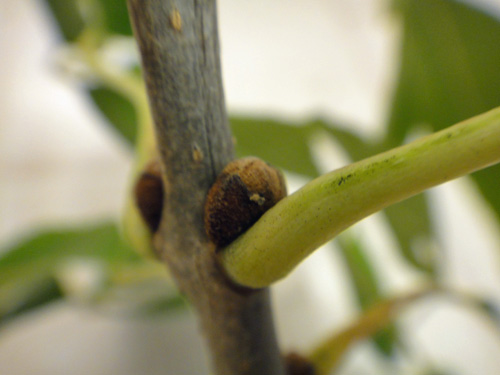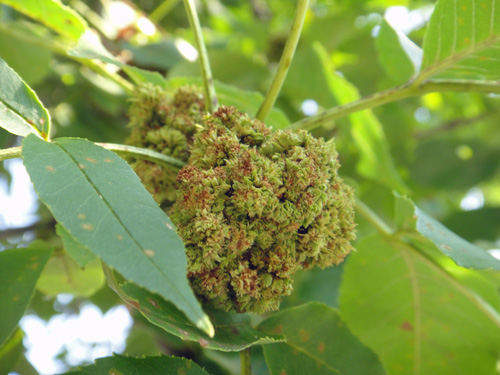The question still remains, what I am going to do now that the men with the pointy sticks
have cut down all the branches and twigs from the tree that I've been
watching since February. I can't reach any of the twigs on the tree
outside the window any more and I can't see anything up close. Fall is coming and I want to watch!
My first thought was to take a look at some of the other ash trees in the neighborhood to see if any of them had some low branches that I could actually reach and examine closely.
Most do not.
But the girl ash tree across the street does have a few branches I can get to.

Interestingly, some of the features on her twigs are quite different from those on the twigs of my boy tree. The first difference I noticed was that this year's growth (the lighter colored bark extending up from the tip of the twig down to the first "knuckle" or ring-like bud scar) is much longer. Like four times as long! I wonder why she managed so much more growth than my tree did. Does it have something to do with the side of the street? Does this side get more sun? Or is this tree maybe healthier? Or is it because it is a female ash tree?
Another thing I noticed was that the developing buds on her twigs are much smaller than they were on my tree's twigs. Just try to find the lateral buds on the female ash tree! The lateral buds should be developing right above the spot where the leaf stem joins to the twig.

Um, where are they? My tree already had big, fat buds that I speculated were close to being done developing. Look, here's how they looked on July 21st, when we came back from vacation.

See! Is this a boy/girl thing too? I'm thinking it might be. Last week, I picked up a twig that was blown off of another boy ash tree down the street during Hurricane Irene and look at the buds on this guy!

Apparently while the girl ash trees are making like 5,000 samaras and seeds, the boys are developing these big fat buds.

Hmmm, maybe the boy buds and girl buds are just different. I mean the boy buds have to make those flowers and all that pollen, so if the girls don't have to do that, maybe they don't need to make giant buds like this.

Speaking of boy stuff, remember how I found those sticky burr things on my tree way back in February and figured out that they were galls created by tiny mites growing in and feeding on the male ash tree flowers? Well, I never saw any new ones develop on my tree, but during my examination of the other ashes in the neighborhood this week, I discovered that a couple of the other boy ashes developed some new galls this spring.

See how they're green instead of the brown that the galls were on my tree? They're this green color in the season when they first develop. Then they turn brown and stay on the tree for a year or two. It's kinda gross to think that this tree had (has??) tiny bugs in it that made these. Ewwww. I wonder why there were (are??) so many of them on these trees across the street but not on my tree.

One more fascinating thing about this discovery. The tree that I found these on is a boy and a girl tree. Some ashes are like that, producing both girl and boy flowers. So this tree has areas where there are lots of samaras and then also areas like this where there are galls (which develop only in male flowers). And, if you look real close, you can see that the twig that these galls are on has big lateral buds growing right where the leaf stems attach to the tree. Well, I'll be darned!
My first thought was to take a look at some of the other ash trees in the neighborhood to see if any of them had some low branches that I could actually reach and examine closely.
Most do not.
But the girl ash tree across the street does have a few branches I can get to.

Interestingly, some of the features on her twigs are quite different from those on the twigs of my boy tree. The first difference I noticed was that this year's growth (the lighter colored bark extending up from the tip of the twig down to the first "knuckle" or ring-like bud scar) is much longer. Like four times as long! I wonder why she managed so much more growth than my tree did. Does it have something to do with the side of the street? Does this side get more sun? Or is this tree maybe healthier? Or is it because it is a female ash tree?
Another thing I noticed was that the developing buds on her twigs are much smaller than they were on my tree's twigs. Just try to find the lateral buds on the female ash tree! The lateral buds should be developing right above the spot where the leaf stem joins to the twig.

Um, where are they? My tree already had big, fat buds that I speculated were close to being done developing. Look, here's how they looked on July 21st, when we came back from vacation.

See! Is this a boy/girl thing too? I'm thinking it might be. Last week, I picked up a twig that was blown off of another boy ash tree down the street during Hurricane Irene and look at the buds on this guy!

Apparently while the girl ash trees are making like 5,000 samaras and seeds, the boys are developing these big fat buds.

Hmmm, maybe the boy buds and girl buds are just different. I mean the boy buds have to make those flowers and all that pollen, so if the girls don't have to do that, maybe they don't need to make giant buds like this.

Speaking of boy stuff, remember how I found those sticky burr things on my tree way back in February and figured out that they were galls created by tiny mites growing in and feeding on the male ash tree flowers? Well, I never saw any new ones develop on my tree, but during my examination of the other ashes in the neighborhood this week, I discovered that a couple of the other boy ashes developed some new galls this spring.

See how they're green instead of the brown that the galls were on my tree? They're this green color in the season when they first develop. Then they turn brown and stay on the tree for a year or two. It's kinda gross to think that this tree had (has??) tiny bugs in it that made these. Ewwww. I wonder why there were (are??) so many of them on these trees across the street but not on my tree.

One more fascinating thing about this discovery. The tree that I found these on is a boy and a girl tree. Some ashes are like that, producing both girl and boy flowers. So this tree has areas where there are lots of samaras and then also areas like this where there are galls (which develop only in male flowers). And, if you look real close, you can see that the twig that these galls are on has big lateral buds growing right where the leaf stems attach to the tree. Well, I'll be darned!
